#saw a megaptera novaeangliae today
Text
i nandesu

#prsk art#prsk fa#prsk ena#ena shinonome#shinonome ena#help#aaaaafhgehgehgdhhwgskjgdkhgwjhwgjhg#tags on tumblr are so fun i love spamming random stuff in them#saw a megaptera novaeangliae today#dotcircledotart
13 notes
·
View notes
Text

Tahafa, a male humpback whale calf with injured pectoral fin and scarred body, with its mother (Vava’u, Tonga 🇹🇴, Pacific Ocean). The humpback whale calf (Megaptera novaeangliae) pictured here was attacked not long after he was born. His right pectoral fin has a large rip in the middle. His dorsal fin was almost cut off, and there were large chunks of flesh missing from several areas of the young whale’s body. No one saw the actual attack, so it is not possible to say with certainty how the calf was injured.
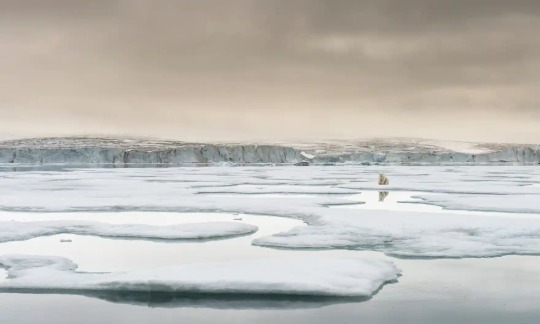
A polar bear juvenile resting on an ice floe (Spitsbergen, Svalbard, Norway 🇳🇴). Things are changing in the Arctic and it’s not for the better. Over the past years, we have clearly seen how the glaciers on Svalbard are retreating and ocean ice is getting thinner. The ice on the fjord, where the seals are having their pups in spring, is also disappearing faster as warm water is being pushed towards the coast. In a world where its inhabitants are dependent on snow and ice, the impact of warmer ocean and air temperatures is devastating.

The Sermeq Kujalleq glacier, Greenland ���🇱, entering the Kangia Ilulissat Icefjord full of icebergs, August 2019. Sermeq Kujalleq is one of the world’s most productive glaciers and the fastest moving one in the world. Within the past 10 years, the glacier has doubled its speed and today it moves about 40 metres every 24 hours. This is because ice from a very large drainage area is concentrated in a narrow stream that follows a deep trough under the glacier. Scientists also believe that rising temperatures result in increasing amounts of meltwater under the glacier.
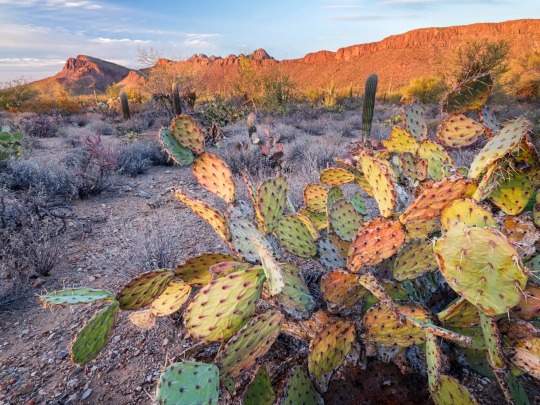
A prickly pear cactus (Opuntia engelmanni), stressed and dying as a result of drought, in the evening light in the Tucson mountains (Saguaro national park, Arizona, USA 🇺🇸). Since 1990, south-west US has experienced some of the most persistent droughts on record due to increasing temperatures. Arizona is currently in its 26th year of a long-term drought.
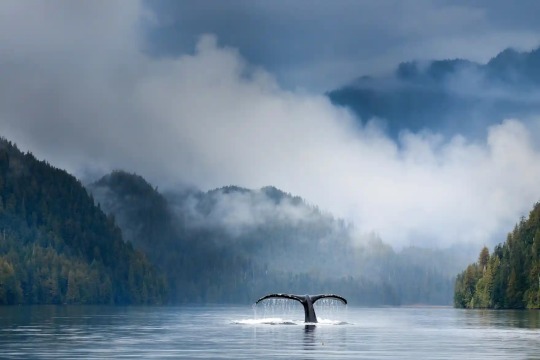
An adult humpback whale (Megaptera novaeangliae) diving in the Great Bear rainforest (British Columbia, Canada 🇨🇦). The intricate mosaic of forests, islands, fjords and mountains in these coastal regions are incredibly rich and biodiverse and support a wealth of wildlife. Pacific salmon that feed in the Bering Sea migrate back to their natal rivers in British Columbia to spawn and die. In autumn the corpses litter the river margins and adjacent forests as bears, wolves and other predators feed on the bounty. The decaying salmon fertilise the entire forest.
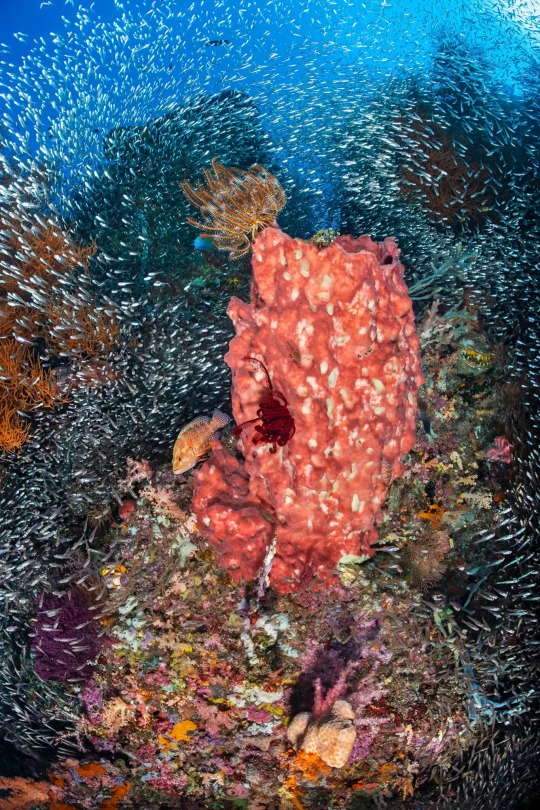
Schools of baitfish, including cardinalfish and silversides, mass on a coral reef, with giant barrel sponge and predatory coral grouper (Misool island, Raja Ampat, West Papua, Indonesia 🇮🇩). Our planet is home to a tremendous diversity of species, but they are not evenly spread. Life is concentrated in certain habitats and the richest of these biodiversity hotspots is a global conservation priority. The richest reefs are in south-east Asia’s coral triangle, which covers just 1.5% of the oceans, yet supports a third of the world’s coral reefs.

A scalloped hammerhead shark (Sphyrna lewini) near the surface, off Baja peninsula (Mexico 🇲🇽). Sharks are feared and revered. The chances of being attacked by one of these enigmatic, perfectly evolved predators is virtually nil, yet humans persecute them relentlessly. Tens of millions of sharks are killed around the world every year – to make shark-fin soup, considered a delicacy in China – and many populations have been fished to extinction. As this photo of a critically endangered scalloped hammerhead shows, sharks are beautiful animals – and without them, our ocean ecosystems would collapse.

Cones of a female welwitschia plant (Welwitschia mirabilis) near Swakopmund (Namib Desert, Namibia 🇳🇦). The cones of a female welwitschia plant extrude like a firework at sunset in the Namib desert near Swakopmund. Welwitschia are among the weirdest and most interesting plants alive today. Endemic to the Kaokoveld desert of Namibia and Angola, they are among the most ancient organisms on the planet: some individuals might be more than 2,000 years old.
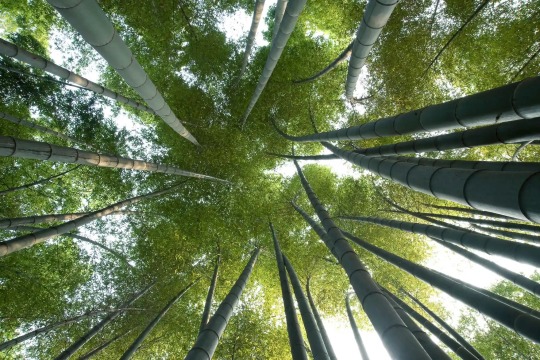
A moso bamboo canopy in Shunan Zhuhai national park (Sichuan province, China 🇨🇳). Moso bamboo (Phyllostachys edulis) is a giant grass capable of adding up to a metre per day, making it one of the fastest-growing plants. This temperate bamboo reaches harvestable size in just five years, so as new shoots are formed annually, the fully grown culms can be harvested each year, which opens up the canopy for younger plants to reach maturity. Eucalyptus trees take 15 years before they are harvested and conifers such as pine, fir, spruce and larch about 40 years.

A red squirrel in a forest, and the same forest pictured after logging (Viken, Norway 🇳🇴). The richer biodiversity is, the more resistant nature is towards climate change. However, nature is under increasing pressure. One of the main threats is modern forestry. The practice of clear-cutting forests not only destroys life/biodiversity but also is a major source of carbon dioxide emissions. This image shows how a hundred-year-old forest can be turned into a biological disaster area in a couple of hours.
5 notes
·
View notes
Text
Saturday, June 24th
What a day! The morning was clear and bright, the water beautifully calm. We headed north again, since the canyon mouth has been so bountiful recently. Along the way we came across an unusual sight- a group of about twenty harbor porpoises (Phocoena phocoena)! We typically see these small animals by themselves or in groups that shy away from the boat. Today however, the harbor porpoises came right up alongside us! They rode along with us for a while, gave us some fantastic looks, then dashed away again.
But that was just the appetizer. We found a Blue whale (Balaenoptera musculus) feeding at the surface! We spent quite a while watching it lunge up through thick clouds of krill. It took a few moments before anyone could turn their eyes away from the sight, but when we did we saw Humpback whales (Megaptera novaeangliae) lunge feeding around us as well. Blue whales are specialists, feeding almost exclusively on krill. Humpback whales are much less picky. They eat small fishes and krill if they can get it. Scattered Sooty Shearwaters (Ardenna grisea) were also taking advantage of the feast.
Two Ocean Sunfish (Mola mola) also made appearances during our trip. The first was about the size of a hubcap. The second would filled a kiddie pool!
In the afternoon, the wind picked up and it became a bit choppier but still comfortable. It didn’t seem possible that we could top the morning trip. But then we discovered a Humpback whale doing repeated tail lobs and tail throws, over and over again! When the whale slapped its flukes down on the water, we could hear the percussive boom it made. We don’t know exactly why whales do this, but it’s probably a way of communicating. This particular whale was missing the tip of one of its flukes, which made it very distinctive. We watched until it calmed down, then continued on and found two more humpbacks also repeatedly slapping their tails on the water. One of these also had scarring on its dorsal fin and rake scars on its flukes, marking it as as survivor of killer whale attack. A fully grown humpback whale has no reason to fear killer whales, but as calves they often face predation.
We rounded out the day with a Black Footed Albatross (Phoebastria nigripes) sighting, and returned to the wharf satisfied with a great day on the water.




Top: Lateral lunging blue whale
Second: Surface lunging humpback whales
Third: Distinctive flukes with rake marks and fluke tip missing
Bottom: Thousands of Sooty Shearwaters
#monterey bay whale watch#mbww#gowhales#blue whales#humpback whales#lunge feeding#pelagic sea birds#Whale Watching#monterey bay
1 note
·
View note
Text
Saturday, June 17th
This morning we had wind and big swells. Our boat, the Point Sur Clipper, was built to take on the rough seas of the North Pacific though, and handled beautifully.
We found Risso’s dolphins (Grampus griseus) just off Lover’s Point, where they’ve been spotted for several days now. It’s Market Squid (Loligo opalescens) spawning season, and the flat sandy bottom offshore there attracts both the squid and the dolphins who feed on them.
Our captain decided not to linger too long with the dolphins-we wanted to get out to the canyon edge while the weather was good. So we wished them good feeding and continued to the northwest. Our destination was the Corner, an area where the Monterey Submarine Canyon bends, and where we’ve been seeing a number of different species recently.
We were near the Corner when the captain received an update from a sister vessel-they’d sighted Killer Whales (Orcinus orca)! Captain Isaiah powered through the swells to get us to the pod before they vanished. We arrived at the site and were rewarded with some great looks at these beautiful animals. With a close look at their dorsals, we recognized some of the orcas! Emma’s group was out today. The naturalist recognized Emma and her grown daughter, Louise, along with 3 others. They came close to the boat several times. We got some great looks at the orcas!
We stayed with Emma’s pod through several dive cycles, then broke off in search of other sightings. The captain and the naturalist both smelled humpback whale breath while watching the orcas, so we headed out to find the culprit.
We found one humpback whale (Megaptera novaeangliae) nearby and saw a possible cow/calf pair further out. As we headed back towards the harbor, a large group of Pacific White Sided dolphins (Lagenorhynchus obliquidens) found us and surfed around the boat for a bit. We rounded out the trip with one last look at the Risso’s dolphins, who accompanied us back to the harbor.
#mbww#gowhales#Whalewatching#humpback whales#Orcas#killer whale#ca transient killer whales#pwsd#rissos dolphins#go whales
1 note
·
View note